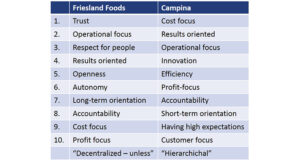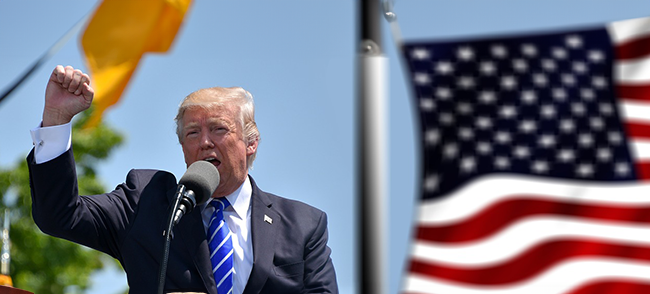
In the field with Royal FrieslandCampina
AT A GLANCE
- Two Dutch dairy cooperatives, each with their own operating companies, faced an increasingly competitive and uncertain European market and so they decided to merge.
- A new CEO was appointed to lead the post-merger integration as well as achieve ambitious revenue and cost cutting targets. But the two companies had very different organizational cultures.
- The CEO successfully led the company through a culture change by engaging the top team to help co-create the values and culture.
- Royal Friesland Campina’s experience offers four learning points for CEOs leading culture change and post-merger integration.
Two dairy cooperatives based in the Netherlands – Campina and Royal Friesland Foods – decided in 2007 to join forces in an effort to better navigate the increasingly competitive and changing European dairy landscape. Both cooperatives owned operating companies that would merge to form Royal FrieslandCampina (RFC) once the deal was approved by the European Union (EU). While waiting for the December 2008 EU decision, the Supervisory Board (SB) of the proposed new entity selected an outsider – Cees ‘t Hart – as CEO of Royal Friesland Foods. He went on to become the first CEO of the merged company. Although the ultimate owners of RFC were its nearly 20,000 member-farmers, the CEO reported to the cooperative’s SB, much like any publicly listed multinational. The CEO’s post-merger challenges were to integrate the two organizations, as well as to achieve ambitious revenue growth and cost-cutting targets. But the two companies had very different corporate cultures (see Figure 1). The new CEO, who had been leading one of the founding companies for only six months, faced multiple challenges. While leading the integration of these two distinct companies, he had to answer to multiple stakeholders, faced an uncertain external environment and had ambitious cost-cutting and revenue targets.
The broader issue
The statistics are clear and depressing. Up to 70% of mergers do not realize the expected synergies, and about 80% fail to increase shareholder value. One contributing factor is that companies often do not even think about the details of blending the company cultures, either before or after the deal. Yet organizational culture is so powerful that former IBM chairman Lou Gerstner once said, ”Culture isn’t just one aspect of the game – it is the game.” Even companies in the same industry can have wildly different cultures, which can lead to problems when merging. The failure of the $38 billion DaimlerChrysler ”merger of equals” in the late 1990s, which saw the share price fall from $108 to $38 in less than a year, was partly attributed to cultural differences. How could the CEO avoid suffering the same fate?
Getting culture right is hard work
What exactly is organizational culture? It refers to “how we do things around here.” It is about how companies deal with customers, innovation, production, how they are organized, how meetings are run, and so on. It is so deeply ingrained that leaders and employees do not realize that it drives their behaviors, which are generally automatic and unconscious. And it is hard to change, even in the best of circumstances. During stressful times, such as in the wake of mergers, leaders and employees will revert to their usual behavior, namely their original organizational culture.
Leaders can increase the likelihood of capturing the synergies and expected performance improvements of a merger by analyzing the culture of the respective companies. They must then decide which behaviors to keep and improve from each company, which ones to leave behind and which new ones to add. And finally, they need to develop processes and structures to reward the use of the desired behaviors and penalize the continuation of the unwanted ones. Changing an organization’s culture requires a lot of work and making hard choices, but it can be done. To do so, companies often measure their culture using self-report surveys. One such survey, used by RFC, is the Denison Organizational Culture Survey. It asks managers questions about their organization and evaluates how the company is doing in four areas that matter in terms of culture (see Figure 2):
- Mission – captures how leaders define the organization’s strategic objective and its values, and also how well it communicates these in a compelling way.
- Adaptability – describes how a company adapts to the changing business environment and customer demands.
- Involvement – focuses on how well a company involves its employees through empowerment, team orientation and development.
- Consistency – assesses how consistent an organization’s core values, agreement and coordination and integration are.
Successful companies balance the tensions between internal integration and external adaptation. The Denison Survey model highlights the tradeoffs between internal and external focus, and between stability and flexibility. It also highlights the diagonal tensions between developing the strategy top down versus a bottom-up approach.
By benchmarking a company against a database of nearly 1,000 other companies, the Denison Survey allows leaders to compare how their company performs on the 12 dimensions and identify areas of improvement. The survey is especially useful during a merger because leaders can see where the companies differ, define the culture to which they aspire and then take concrete action to change.
A merger of equals
RFC’s CEO had a challenging mandate: Oversee the post-merger integration while reaching ambitious revenue growth and cost-cutting targets. He believed the new organization could reach these goals only if the two former competitors worked together, and with the right team.
He and the SB first focused on picking a new Executive Board (EB). Although not a criterion for the new EB, there was roughly 50% representation from each of the founding companies, triggering awkwardness among the members because they had to work closely with their former competitors. One EB member expressed his utter discomfort at finding himself on the same team as “his enemy.”
When making decisions, leaders often neglect to account for emotions. However, the CEO recognized that the atmosphere at meetings was tense because the EB members had been fierce competitors. Thus, he built time into early EB meetings to allow the members to get to know one another as people rather than as faceless competitors.
The CEO then worked with the SB and the new EB to form the next level of management – the Top 70, which included the EB as well as the top line and functional executives. They asked the top managers from both companies to reapply for their positions. Again, and not by design, the Top 70 team had almost equal representation from each of the companies.
As with any merger, there were leaders who wanted to be part of the new team but were demoted, asked to leave or left the company of their own accord. In general, this kind of painful reality adds to the stress of all involved, especially those who leave, and “survivors” tend to fall back into their known behaviors – those rooted in their original organizational cultures. This makes change even more difficult.
RFC’s newly appointed Top 70 harbored the same hostile feelings as the EB members. The CEO emphatically believed that the new company needed a culture change to be successful and that the Top 70 had to deliberately choose a unique “one FrieslandCampina” and not the “weighted average of the two cultures.”
Over the course of a year, the EB met regularly, both alone and together with the rest of the Top 70. Simultaneously, the CEO and the Top 70 focused on defining the strategy and the shared values needed for RFC to successfully achieve its goals.
Did it work?
The process of co-creating the strategy and values fostered strong buy-in and commitment, which the Top 70 then enthusiastically cascaded throughout the organization. Although the strategic framework revealed serious capability gaps, these were filled through a combination of recruitment and training. After three years, RFC had a strong strategic direction, clear goals and objectives as well as a vision. Its employees were empowered and it had solid capability development.
Reaping the benefits
Drawing on our work with RFC, we can share the following insights for companies about to embark on a merger:
Organizational culture matters. Leaders should recognize its importance and systematically develop an understanding of which behaviors work and can be built upon, which ones do not work and need to be eliminated, and finally which ones should be added. Leaders then need to integrate those behaviors into the values of the organization with the support of HR systems and processes.
Engaging the newly combined leadership in a strategy co-creation process is essential to ensure that the selected values and behaviors serve the agreed long-term strategy.
The needs of the organization will evolve. Therefore, leaders need to track their culture over time to see how it is doing and adapt it to suit the changing business environment and strategic direction.
Organizational change generally causes stress and negative emotions. Recognize this reality and give leaders as well as employees the time and space to work through it. That said, tough decisions on personnel in terms of fit and capability are inevitable.
For RFC to reach these ambitious goals, it needs a unique ‘one FrieslandCampina’ culture and not one that is simply the average of the old ones.
Cees‘t Hart – Former CEO of Royal Friesland Campina, CEO of Carlsberg Group
THIS ARTICLE IS BASED ON THE AUTHORS’ THREE-PART IMD CASE SERIES: IMD-7-1599 to IMD-7-1601, 2016, AVAILABLE FROM THE CASE CENTRE.
Research Information & Knowledge Hub for additional information on IMD publications
While retail company AllSaints had delivered a great performance in 2022 – with revenues of £470 million – it faced multiple challenges. First, keeping stores open was a fundamental strategy for the company to connect to customers and deliver a be...
This note, designed for use in sessions and programs on negotiation, explores five distinct negotiator types: competitor, collaborator, strategist, innovator and problem solver. Each type has unique characteristics, strengths and weaknesses that c...
Founded by Lim Hock Chee in 1985, Sheng Siong has evolved from a humble grocery store into a leading supermarket chain in Singapore, renowned for its cost-effective pricing and commitment to customer satisfaction. Mr Lim’s unique philosophy, which...
This technical note introduces two powerful frameworks for navigating complex, rapidly changing business environments: TSUNAMI and SURF. The TSUNAMI framework provides a comprehensive tool for assessing external challenges across seven dimensions:...
The GreenGro (A) case explores the challenges faced by GreenGro, a mid-sized agricultural technology company, as it navigates a rapidly changing industry landscape. CEO Sarah Chen and her leadership team are confronting issues ranging from technol...
The GreenGro (B) case study is a follow-up to GreenGro (A) and details how the company applied the TSUNAMI and SURF frameworks to address its complex challenges. The case illustrates the practical implementation of these frameworks, introduced in ...
Research Information & Knowledge Hub for additional information on IMD publications
Research Information & Knowledge Hub for additional information on IMD publications
Research Information & Knowledge Hub for additional information on IMD publications
Research Information & Knowledge Hub for additional information on IMD publications
Research Information & Knowledge Hub for additional information on IMD publications
Research Information & Knowledge Hub for additional information on IMD publications
The GreenGro (A) case explores the challenges faced by GreenGro, a mid-sized agricultural technology company, as it navigates a rapidly changing industry landscape. CEO Sarah Chen and her leadership team are confronting issues ranging from technol...
The GreenGro (B) case study is a follow-up to GreenGro (A) and details how the company applied the TSUNAMI and SURF frameworks to address its complex challenges. The case illustrates the practical implementation of these frameworks, introduced in ...
in I by IMD
Research Information & Knowledge Hub for additional information on IMD publications
in I by IMD
Research Information & Knowledge Hub for additional information on IMD publications
Research Information & Knowledge Hub for additional information on IMD publications
This technical note introduces two powerful frameworks for navigating complex, rapidly changing business environments: TSUNAMI and SURF. The TSUNAMI framework provides a comprehensive tool for assessing external challenges across seven dimensions:...
The GreenGro (B) case study is a follow-up to GreenGro (A) and details how the company applied the TSUNAMI and SURF frameworks to address its complex challenges. The case illustrates the practical implementation of these frameworks, introduced in ...
Research Information & Knowledge Hub for additional information on IMD publications
This technical note introduces two powerful frameworks for navigating complex, rapidly changing business environments: TSUNAMI and SURF. The TSUNAMI framework provides a comprehensive tool for assessing external challenges across seven dimensions:...
The GreenGro (A) case explores the challenges faced by GreenGro, a mid-sized agricultural technology company, as it navigates a rapidly changing industry landscape. CEO Sarah Chen and her leadership team are confronting issues ranging from technol...



